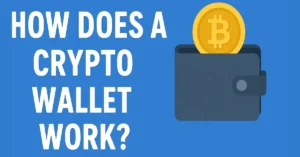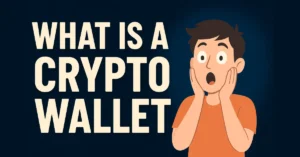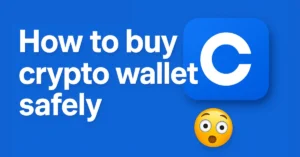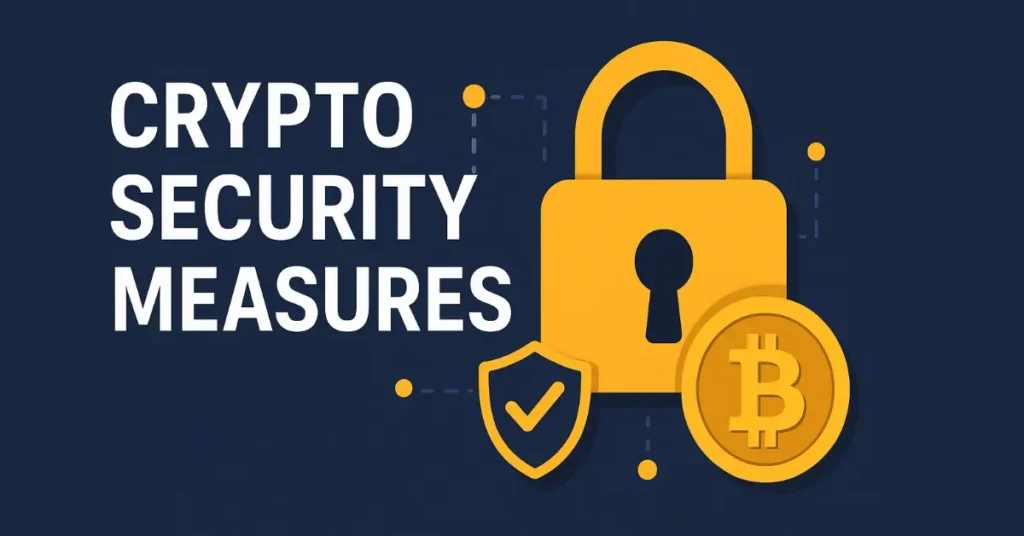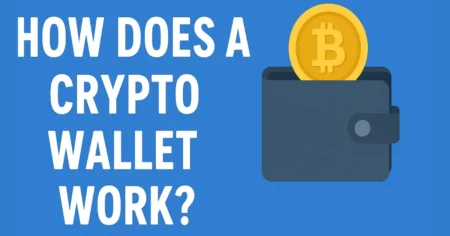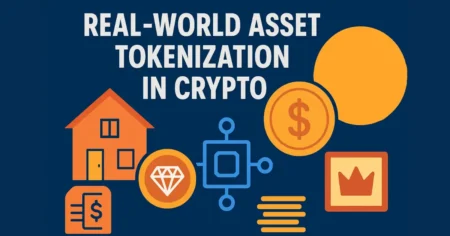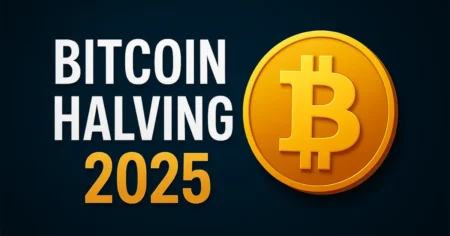Cryptocurrency is no longer just an experimental technology—it has evolved into a major financial asset class with trillions of dollars in circulation. From Bitcoin and Ethereum to stablecoins and emerging altcoins, crypto is now part of mainstream investing. But with great potential comes great risk. Hackers, scammers, and cybercriminals are constantly innovating new ways to steal your hard-earned digital wealth.
In 2025, the importance of crypto security measures cannot be overstated. Whether you’re a casual investor or a seasoned trader, failing to protect your crypto could mean losing everything in seconds. This article will guide you through proven strategies, best practices, and insider tips to keep your assets safe from digital threats.
We’ll cover everything—from recognizing common attack methods to securing your wallet, protecting your identity, and avoiding rookie mistakes that could cost you dearly. Think of it as your complete crypto survival manual for today’s digital battlefield.
Introduction to Crypto Security
Why Crypto Security Matters More Than Ever
Crypto isn’t like money in your bank account. If your credit card gets hacked, your bank can reverse the charges. If your crypto gets stolen, it’s almost impossible to recover. Transactions on the blockchain are irreversible—once coins are moved out of your wallet, they’re gone for good.
With the growing adoption of crypto in the U.S., more people are holding significant amounts of their net worth in digital assets. Unfortunately, criminals see this as a golden opportunity. According to cybersecurity reports, crypto-related thefts exceeded $3 billion globally in 2024, and experts predict an even higher figure in 2025.
The rise of DeFi (Decentralized Finance), NFTs, and Web3 platforms has also introduced new attack vectors. Smart contract exploits, rug pulls, and fake token schemes are becoming increasingly sophisticated. This means the average user must take personal responsibility for security—there’s no “crypto customer service” to bail you out.
My advice? Treat your crypto holdings like a vault of gold bars sitting in your living room. You wouldn’t leave the front door open, so don’t leave your digital doors unlocked either.
The Rising Threat Landscape in 2025
Hackers are not only more creative but also more resourceful than ever. Artificial intelligence, deepfake technology, and automated bots are being weaponized to trick investors. For example:
AI-driven phishing can create emails or websites that perfectly mimic trusted crypto services.
Blockchain analytics tracking can identify wealthy wallets, making them prime targets.
Sophisticated malware can bypass basic antivirus tools and steal your seed phrase without you noticing.
What’s scarier is that these attacks are no longer just targeted at big whales—everyday investors are fair game. Hackers often prefer smaller accounts because people with modest holdings tend to be less vigilant.
In short, the crypto threat landscape is fast-moving, global, and relentless. Staying secure in 2025 means constantly updating your knowledge and adapting your defenses.
Understanding Common Crypto Threats
Before we talk about protection, you need to know the enemy. Cybercriminals use a variety of methods to compromise your funds, and recognizing these early can save you from disaster.
Phishing Attacks
Phishing remains the number one crypto scam. This is where attackers pretend to be a legitimate company—like Coinbase or Binance—to trick you into revealing your private keys or login details. They may send emails with urgent warnings like “Your account has been compromised! Log in now to secure your funds.” The link then leads to a fake website designed to steal your credentials.
Pro tip: Always type the official URL yourself. Never click on links in unsolicited emails or messages, even if they look real.
Malware and Ransomware
Crypto-focused malware can sit quietly on your device, waiting to steal passwords or intercept transactions. Clipboard hijackers, for example, replace copied wallet addresses with the attacker’s address. Some ransomware strains now demand payment exclusively in cryptocurrency because it’s harder to trace.
Regular device scans, software updates, and avoiding suspicious downloads are key to staying malware-free.
SIM Swapping and Identity Theft
SIM swapping is when a hacker convinces your mobile carrier to transfer your phone number to their device. Once they have control, they can bypass two-factor authentication codes sent via SMS and access your Exchange accounts.
To protect yourself, set up a PIN or port freeze with your carrier and avoid linking SMS authentication to sensitive accounts.
Exchange Hacks
Centralized exchanges store billions of dollars’ worth of cryptocurrency, making them prime hacker targets. While major exchanges have improved security, breaches still happen. If an exchange is hacked, you could lose funds stored there.
That’s why experts recommend “Not your keys, not your coins”—meaning you should store crypto in wallets you control, not on exchanges.
Wallet Security – The First Line of Defense
Your crypto wallet is like your digital safe. Choosing the right one and securing it properly is crucial.
Hot Wallet vs Cold Wallet
- Hot Wallet: Connected to the internet, convenient for frequent trading, but more vulnerable to hacking.
- Cold Wallet: Offline storage (like hardware or paper wallets), far safer from online attacks but less convenient for quick transactions.
For large holdings, use a cold wallet. Keep only the amount you need for trading in a hot wallet.
Hardware Wallet Benefits
A hardware wallet is a small physical device—like a USB stick—that stores your private keys offline. Even if your computer is infected with malware, a hardware wallet keeps your keys secure because transactions must be approved on the device itself.
Popular brands like Ledger and Trezor offer excellent protection for long-term storage. Just be sure to buy directly from the manufacturer to avoid tampered devices.
Paper Wallets – Pros and Cons
A paper wallet is simply a printed copy of your private and public keys. It’s completely offline, making it immune to online attacks. However, paper can be lost, stolen, or destroyed. Water damage, fire, or even a curious roommate can compromise it.
If you use a paper wallet, laminate it, store it in a safe, and make multiple copies in different locations.
Best Practices for Safe Transactions
Even with a secure wallet, your transactions can be intercepted or redirected if you’re not careful.
Verifying Wallet Addresses
One common trick hackers use is changing the copied wallet address on your clipboard to their own. Always double-check the first and last few characters of an address before sending funds.
Avoiding Public Wi-Fi for Crypto Transactions
Public Wi-Fi networks are a hacker’s playground. Man-in-the-middle attacks can intercept your data, including wallet credentials. If you must trade while traveling, use a personal hotspot instead.
Using VPNs for Added Privacy
A VPN (Virtual Private Network) encrypts your internet connection, hiding your IP address and preventing tracking. This not only improves privacy but also helps bypass geo-restrictions on certain exchanges.
Multi-Factor Authentication and Strong Password Management
Your exchange and wallet accounts are only as strong as their weakest password.
Creating Strong Passwords
Avoid using obvious passwords like “Bitcoin123.” A strong password should be long (at least 12 characters), include numbers, symbols, and both upper- and lowercase letters.
Password Managers
Password managers like LastPass, 1Password, or Bitwarden securely store and generate complex passwords so you don’t have to memorize them.
MFA and 2FA Best Practices
Multi-factor authentication adds another layer of protection, requiring something you know (password) and something you have (authenticator app). Avoid SMS-based 2FA when possible—use an authenticator app or hardware security key instead.
Securing Your Private Keys and Seed Phrases
Your private keys and seed phrases are the ultimate access codes to your cryptocurrency. If someone gets hold of them, they gain full control of your assets. Unlike a lost credit card, you can’t just “cancel” a private key or ask the blockchain for a new one—it’s a one-time, do-or-die secret.
Why Private Keys Are Non-Negotiable
Think of your private key as the master key to your vault. Without it, you can’t access your funds. With it, anyone can move your crypto. This is why security experts constantly stress: Never share your private key with anyone—ever.
Even trusted friends or family should not have easy access. If they truly need it for inheritance planning, use a secure, legally documented process rather than casually giving them the details.
Offline Storage of Seed Phrases
Your seed phrase (often 12–24 random words) is like a recovery code for your wallet. If your device fails, the seed phrase can restore your funds in a new wallet.
Best practices include:
- Writing it on paper (never digital files)
- Storing multiple copies in secure, geographically separate locations
- Avoiding photos, screenshots, or cloud storage—these are easy hacker targets
Some crypto veterans even engrave their seed phrase on metal plates to protect against fire or water damage.
Splitting and Encrypting Seed Phrases
For extra safety, you can split your seed phrase into two or three parts and store them separately. This way, a thief would need all parts to access your funds. Encryption adds another layer of complexity for hackers, but remember—you must securely store the encryption key as well.
Choosing Secure Crypto Exchanges
While “Not your keys, not your coins” remains the golden rule, most people still use exchanges for trading. Choosing the right platform can make a huge difference.
Regulation and Compliance
Stick with exchanges regulated in the USA or other countries with strong financial oversight. This doesn’t guarantee safety, but it reduces the risk of outright scams and ensures some level of accountability.
Security Features to Look For
A reputable exchange should have:
- Cold storage for most funds
- Insurance for digital assets
- Withdrawal whitelist addresses
- 2FA via authenticator app or hardware key
- Regular third-party security audits
- Avoiding Low-Quality Exchanges
Small, obscure exchanges may offer attractive fees, but they often lack robust security. Many disappear overnight in “exit scams,” taking user funds with them. Always research the exchange’s reputation before depositing large sums.
The Role of Decentralized Finance (DeFi) Security
DeFi platforms have exploded in popularity, offering everything from lending to staking without intermediaries. But DeFi comes with its own set of risks.
Smart Contract Vulnerabilities
DeFi apps run on smart contracts—code that executes transactions automatically. If there’s a bug or loophole, hackers can drain funds instantly. Even audited contracts can have hidden flaws.
Rug Pulls and Fake Projects
Some DeFi projects are outright scams. Developers lure in investors with high returns, then suddenly withdraw all liquidity and vanish—a tactic known as a “rug pull.”
To avoid these traps:
- Check the team’s identity and track record
- Look for transparent code audits
- Avoid deals that seem “too good to be true”
Managing DeFi Exposure
Never put all your crypto in a single DeFi platform. Spread risk across different projects, and only invest what you can afford to lose.
Recognizing and Avoiding Crypto Scams
Scams are getting harder to spot, especially with AI-generated content and fake endorsements.
Social Media Impersonators
Fraudsters create profiles pretending to be well-known crypto influencers. They promise “exclusive investment opportunities” or “giveaways” that require you to send crypto first. Real influencers never ask for money directly.
Fake Wallet Apps
Some fake wallets mimic popular brands but steal your funds when you transfer them in. Only download apps from official sources and verify the publisher’s name.
Too-Good-To-Be-True Offers
If someone promises a guaranteed 200% return, it’s a scam. Crypto investments can be profitable, but no legitimate platform can guarantee risk-free profits.
The Importance of Regular Security Audits for Individuals
When most people hear the term “security audit,” they think of big corporations. But in the crypto world, individual investors need them too. A personal security audit simply means taking time to review how and where your crypto is stored, and identifying potential weak spots before hackers do.
Reviewing Your Devices
Start by checking the health of your computer and smartphone. Make sure your operating system is updated, all software is patched, and antivirus tools are active. If you’ve been downloading random files or visiting questionable sites, consider a complete system wipe before reconnecting to your crypto wallets.
Updating Wallet Firmware
If you use a hardware wallet, ensure it’s running the latest firmware. Manufacturers like Ledger and Trezor often release updates that patch vulnerabilities or add new security features. Skipping these updates leaves you exposed to known threats.
Revoking Old Permissions
Many crypto wallets let you connect to decentralized apps (dApps). Over time, you may forget about these connections, but they can still interact with your wallet. Use tools like Revoke. Cash to see and remove unnecessary permissions, reducing your exposure to malicious smart contracts.
Education as a Security Measure
You can’t protect yourself from threats you don’t understand. Staying informed is just as important as having strong passwords or secure wallets.
Following Reliable Sources
In the U.S., reputable platforms like CoinDesk, The Block, and official exchange blogs provide timely security updates. Avoid relying solely on social media, where rumors and misinformation spread quickly.
Participating in Crypto Communities
Online forums like Reddit’s r/CryptoCurrency and Twitter’s crypto circles can help you learn from others’ mistakes and successes. Just remember—always verify information before acting on it.
Taking Formal Crypto Security Courses
Many platforms now offer structured training on blockchain security, wallet management, and scam detection. Some are even free, and they can give you a strong foundation for protecting your assets.
Emergency Planning for Crypto Investors
Even the most cautious investor can face unexpected problems—device theft, natural disasters, or sudden illness. Having an emergency plan ensures your crypto isn’t lost forever.
Creating a Recovery Plan
Write down clear instructions for accessing your wallets, stored in a secure location only trusted heirs or executors can find. This avoids the common tragedy of crypto being locked away forever after the owner’s death.
Using Multi-Signature Wallets
A multi-sig wallet requires multiple private keys to authorize a transaction. For example, 2-of-3 keys may be needed, meaning no single person can move funds without another’s approval. This is excellent for shared investments or estate planning.
Backing Up Your Data
Keep encrypted backups of wallet files, seed phrases, and important documents on offline storage devices. Store them in fireproof safes or safe deposit boxes, ideally in different locations.
Keeping Emotions Out of Crypto Security Decisions
Security mistakes often happen when emotions take over—panic, excitement, or greed. Scammers know this and use urgency as a weapon.
Avoiding FOMO (Fear of Missing Out)
A sudden price spike or “limited-time offer” can cloud judgment. If you feel pressured to act fast, step back and verify the opportunity first.
Resisting Panic Selling
During a market crash, some investors rush to transfer or sell assets, often making mistakes like sending funds to the wrong address. Stay calm, double-check every step, and never let fear dictate your security practices.
Practicing Patience and Discipline
Good security habits require consistency. Make it a habit to check addresses, update software, and monitor your accounts regularly—even when nothing seems wrong.
Conclusion
In 2025, securing your cryptocurrency isn’t just about using a strong password or buying a hardware wallet—it’s about adopting a full spectrum of protective measures. From understanding the latest hacking trends to planning for emergencies, crypto security is a continuous process, not a one-time setup.
The reality is simple: the blockchain itself may be secure, but the endpoints—you and your devices—are the weak links. By taking responsibility for your digital safety, you not only protect your wealth but also help strengthen the entire crypto ecosystem.
In the end, think of crypto security like personal fitness: you can’t buy it once and forget about it. It requires daily attention, learning, and discipline. But if you put in the effort, you can navigate the crypto world with confidence, knowing your digital assets are as safe as they can be.
FAQs
What’s the safest way to store cryptocurrency?
The safest method is using a hardware wallet kept offline, with your seed phrase stored securely on paper or metal, never online.
Is two-factor authentication enough for crypto accounts?
It’s a strong layer of defense, but use app-based or hardware-based 2FA instead of SMS for maximum protection.
Can I recover stolen cryptocurrency?
In most cases, no. Blockchain transactions are irreversible, which is why prevention is far more important than recovery.
How often should I do a personal crypto security audit?
At least twice a year, or after any major changes to your wallets, devices, or exchange accounts.
Are decentralized exchanges safer than centralized ones?
They remove the need to trust a central authority, but still carry risks like smart contract bugs and phishing attacks.
Also, read
- What is a crypto wallet, and how does it work? – Coinsify
- 10 Crypto Terms Every Beginner Must Know: Coinsify
- What is blockchain technology? Complete Guide – Coinsify
- How to Buy Crypto Safely in 2025: Complete Guide – Coinsify
- Bitcoin vs Ethereum: Key Differences Explained: Complete Guide
- Ultimate Blockchain Glossary: Learn Blockchain Terms Easily
- How to Buy Bitcoin Safely (Complete Beginner’s Guide)
- Top 10 Crypto Wallets for Beginners (2025 Edition)
- What is cryptocurrency? A Beginner-Friendly Guide (2025)
